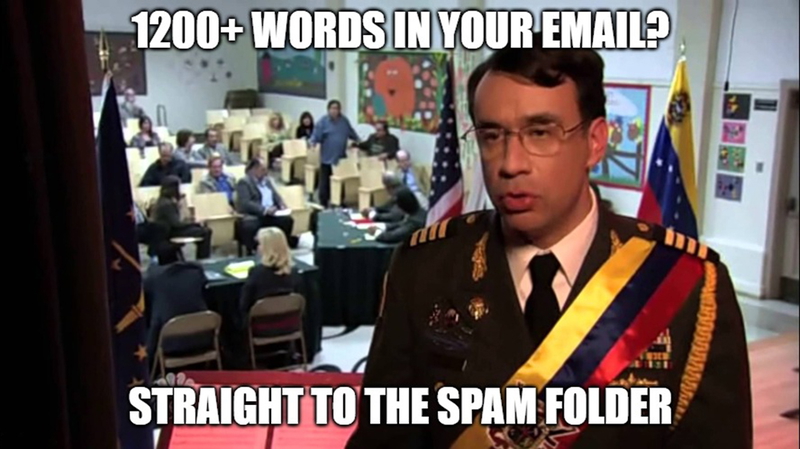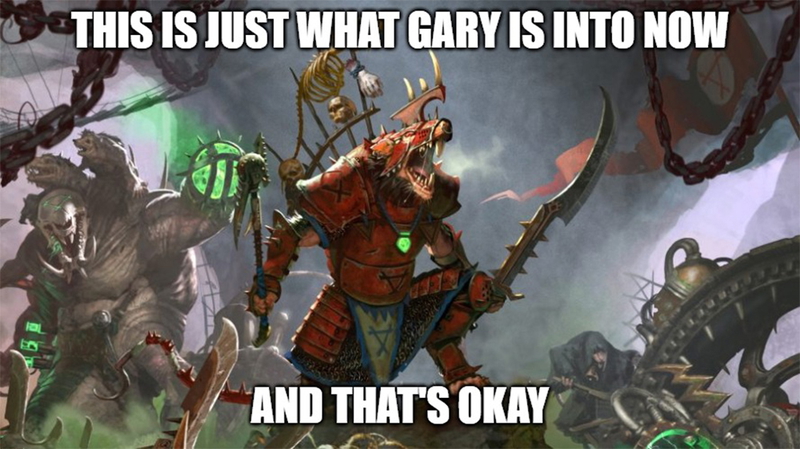In my storied career as a copyologist, I have noticed a few common pitfalls repeatedly made by novice or beginner copywriters. The astute among you might be thinking right now, “I bet he’s demonstrating some mistakes with this preamble.” No. I am not. Everything here is flawless.
Here are the common mistakes I see:
1. Your marketing copy is trying to explain everything
Like the first act of a mediocre screenplay, the most common mistake a copywriter can make is too much exposition. Far too often, when composing marketing emails for virtual events or website copy, writers feel the need to explain absolutely every nuance about the product.
Stop that.
There is a time and a place for a good old-fashioned deep dive. Case in point: This article is an explainer on an insights blog. I can spend 1,200+ words espousing copy wisdom. If this were an email, it would be booted straight to a spam folder.

Less is more.
For example, if you want a friend to see the movie “There Will Be Blood,” what do you think will be more effective:
- Showing them a clip of Daniel Day-Lewis shouting, “I drink your milkshake.”
-
Explaining to them directly that “There Will Be Blood” is a 2007 film from legendary director Paul Thomas Anderson, who is known for “Magnolia,” “Hard Eight,” “Inherent Vice,” and more. It centers on a ruthless, shrewd prospector who pivots from precious metals to oil after stumbling across a large oil field. He tricks local landowners into selling seemingly barren land to build his empire. The film’s themes center around greed, obsession, family, and pride.”
Your audience doesn’t need to know all the context; they simply need to be compelled. Show me the electric performance and even though I don’t know anything else about the film, I’m in. Explain the plot and the themes, and I fall asleep. And no, it's not the narcolepsy or the extremely late night filled with too much rose and not enough water.
2. You are not thinking about your audience when you compose marketing copy
Related to the above, when we’re in our head and have a cool idea, we are fundamentally in a different place than an audience. We are excited to share something that we understand inside and out.
People are exhausted; thus the people you are writing for are exhausted. They work too hard, they have complex family situations, they are getting spam called every other hour, and, to top it all off, a firehose of useless emails are flooding their work inbox, their personal inbox, and their old personal inbox that they keep meaning to go through but never find the time. Have you ever done laundry? Have you ever noticed that no matter how often you do it, you still need to do it?
Managing day-to-day existence is brutal.
The last thing anyone has the bandwidth to do is absorb a granular explanation of the topics you will cover in your upcoming virtual event about the importance of grain futures.
Copy is an invitation. You need to be brief. It is the marketing equivalent of a friend saying, “Hey bud, we’re going to hit [your local bar’s name here] and grab some drinks if you want to join us. No pressure.”
It should not be “Hey man, I’m going to head to [your local bar’s name here] with [a long list of friends and people you don’t know.] Gary has been really struggling with his recent divorce and could likely use some company. In particular, he could use someone to just sort of let him talk about Warhammer miniatures, which he’s really gotten into ever since Cindy left him. For reference, Gary is currently using Orks but he’s Skaven-curious.”

All of that other information might be pertinent and true, but it doesn’t have to be explained in the invite. Your exhausted friend receiving a friendly, “Here’s what we’re doing if you want to join us” will be a lot more likely to opt in than the same friend getting the invite burdened with overwhelmingly niche information.
Understanding what your audience has bandwidth for and trusting them to connect the dots will open up possibilities. If you assume your audience wants nothing more than to read your words, you’ve already lost them. If you don’t trust them to follow along or fill in the blanks, they’ll feel talked down to.
You might be interested in 7 ETF marketing tactics to attract investors.
3. Your word choices and sentence structures are repetitive
Sometimes, just to get some copy on paper, you write messy. You use the word “messy” in two sentences in a row, like I just did. Don’t do that. There are so many words. Too many, really. Pick a different one. Be ruthlessly precise.
The same goes for sentence structure. SEO best practices have made many copywriters prioritize short sentences. Variety is better. You don’t want your readers to get bored, and changing up your rhythm can help keep your writing electric and unpredictable.
Back in the aughts, I attended an acting class led by legendary theatre actor Yoshi Oida. For one of the exercises, he made everyone individually enter a room, pick up a knife, and then exit the room. You were not allowed to “decorate” the performance via emoting or saying anything. You had to maintain a neutral expression. The only tool you had to tell a story was the rhythm of how you performed these actions. And that is more than enough!
If you simply walk in the room, pick up the object and leave, that’s vague. But if you enter and then stare at the knife for a long time before slowly picking it up … and then suddenly, rapidly exiting, well, heck yeah, now we got a story! The audience starts filling in the blanks.The rhythm of the action engages the audience's imagination. When people are actively thinking about what they’re seeing, they’re invested.
Copy works the same way.
4. You aren’t editing or iterating enough
This is a big one. When we get an idea we like, we are prone to committing when we should be iterating. Part of this is excitement. When we feel good about something, we want it to be seen and we want to be recognized for having thought of it. But ideas are not the finished product. They are a prototype, a version 0.1. The best thing you can do is get it into the hands of a few people and get useful, actionable edits. Even sitting on something for a bit and then reapproaching it in the future can be helpful. There’s a reason feature films have rough cuts and video games have early access builds.
If you like the way your “perfect” idea works, do something completely different. Give yourself multiple angles of attack for a single piece of copy. You might have stumbled onto the best option right away, but more often than not, iterating and listing five or six options will lead to something better. Even if it doesn’t, and you come back to that original idea, the work is never wasted. It could:
- Help you better understand what makes your first idea exceptional
- Be repurposed as part of a different campaign or project down the road
-
Keep your mind sharp, flexible, and open to new discoveries
A core part of this is actively embracing change at any time. This will be your superpower because lots of writers, even copywriters, can feel personally attacked when they receive a note. A note is an opportunity.
Notes sometimes come in because a client or supervisor wants something different and better, but they also sometimes come in because you are on to something and aren’t quite there yet. Don’t judge the note or assume the note is a judgement passed on you. Embrace the opportunity to iterate and try something new or edit and punch up what you have.
.jpeg)
Final thoughts
There’s more to copy than most writers assume, and there are a lot of trends and bad advice out there. But you will find success if you:
- Minimize exposition.
- Consider your audience and the medium
- Vary your words, sentence structures, and flow.
- Edit and iterate at every opportunity
If you are looking for marketing and distribution support, check out VettaFi’s digital marketing services. Our experts will partner with you to create compelling content, display ads, virtual event emails, and more.






